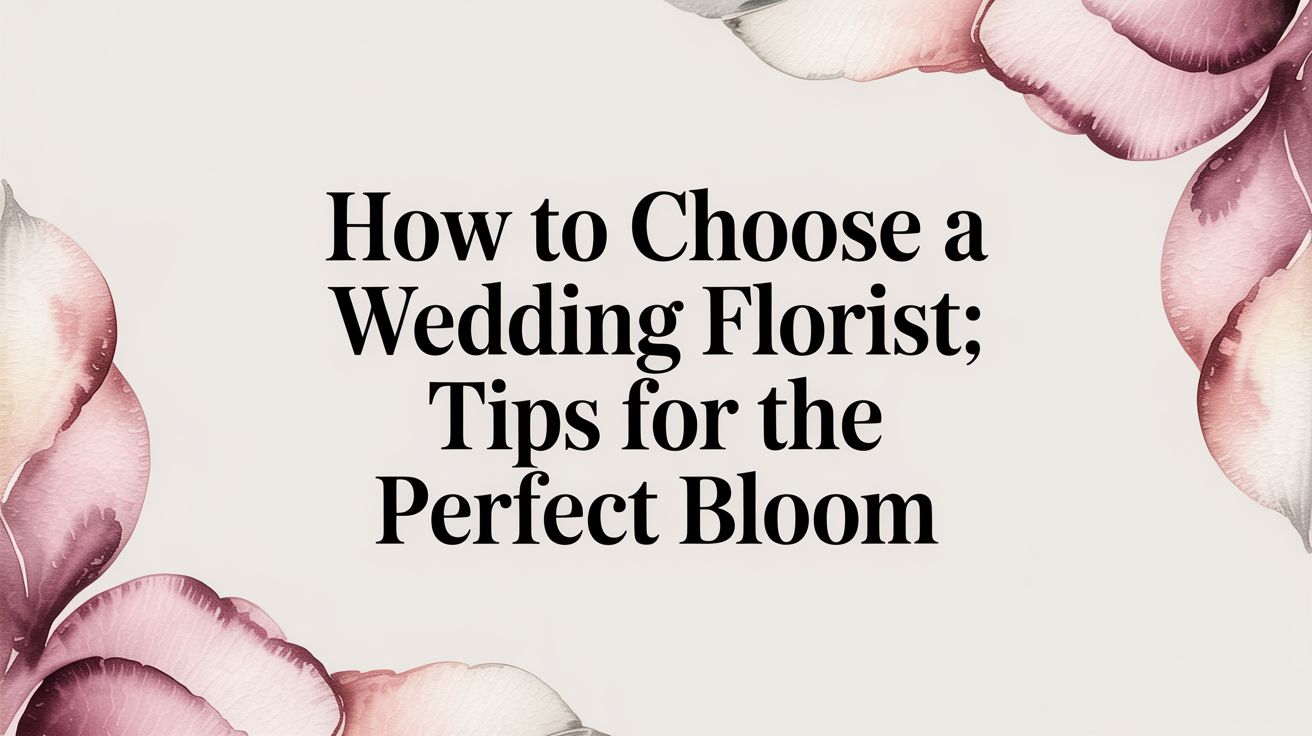Before you even start Googling florists, there are a couple of crucial things you need to figure out first: your style and your budget. This isn't the boring part—it's the foundation for everything. Getting this clear from the get-go means you can focus your search and find a designer who truly gets you.
Translating Your Wedding Vision into Flowers
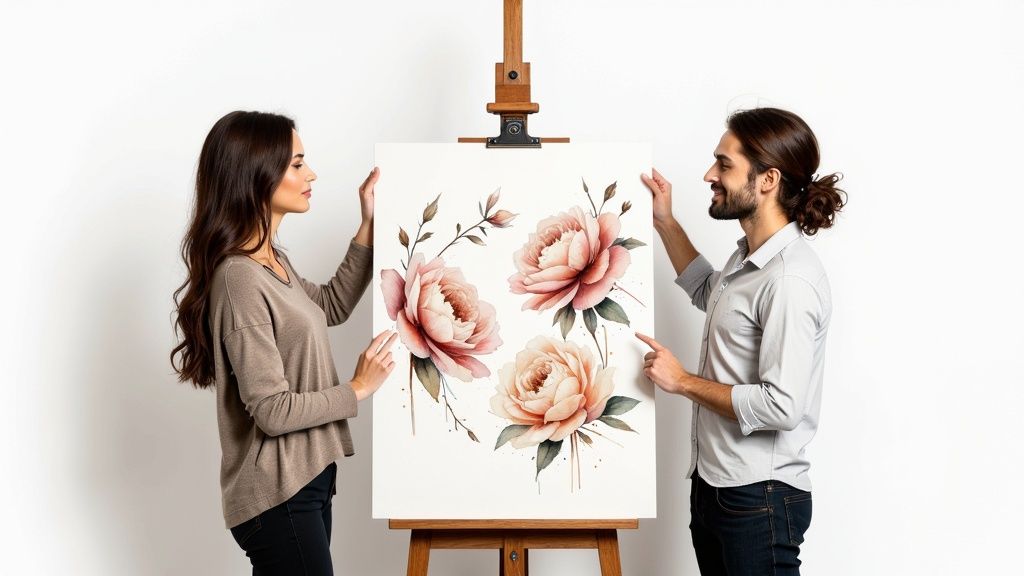
Think of this early planning stage as creating a roadmap for your florist. It’s about more than just picking out pretty pictures; it's about translating the entire mood of your wedding into a visual language an artist can understand. When you do this groundwork, your first conversations with potential florists will be so much more productive and, honestly, way more fun.
Define Your Floral Aesthetic
First things first, you need to nail down your style. Are you dreaming of a romantic English garden vibe, overflowing with lush arrangements? Or are you drawn to the clean, sculptural lines of modern floral design? Maybe you're all about that bohemian look with wispy wildflowers and dried grasses.
The best way to figure this out is to create a dedicated Pinterest board. But don't just pin every flower you see. Start looking for the patterns in what you save.
- Color Palette: What colors keep showing up? Are they soft pastels, moody jewel tones, or something bright and vibrant?
- Flower Shapes: Are you pinning big, dramatic blooms like peonies and garden roses, or do you lean toward delicate, airy flowers like cosmos and baby's breath?
- Overall Mood: Try to describe the feeling. Is it classic? Whimsical? Organic? Dramatic?
A well-curated mood board is your most powerful communication tool. It moves the conversation beyond words and shows a florist exactly what resonates with you, ensuring you're both on the same creative page from the very beginning.
Set a Realistic Flower Budget
Just as important as your style is your budget. Let’s be real: flowers are a significant investment, and having a clear number in mind helps guide every single decision. On average, couples in the U.S. spend somewhere between $1,800 and $3,500 on their wedding flowers, which usually shakes out to about 8-10% of the total wedding cost.
Knowing your number helps you prioritize what really matters to you. For example, if you absolutely must have a breathtaking ceremony installation, you can decide to allocate more of your budget there and go with simpler centerpieces.
Being upfront about your budget with potential florists is key. It allows them to give you realistic ideas and find creative ways to make the most of what you have to spend. For a deeper dive, check out our guide on how to choose your wedding flowers. Getting this sorted out now sets the stage for a much smoother search.
Alright, you've got your mood board, you know the vibe you're going for, and you're buzzing with ideas. Now for the really fun part: finding the floral artist who can take that vision and make it a reality.
This isn't just about a quick Google search. We're on a mission to find a handful of true gems whose work genuinely makes your heart skip a beat.
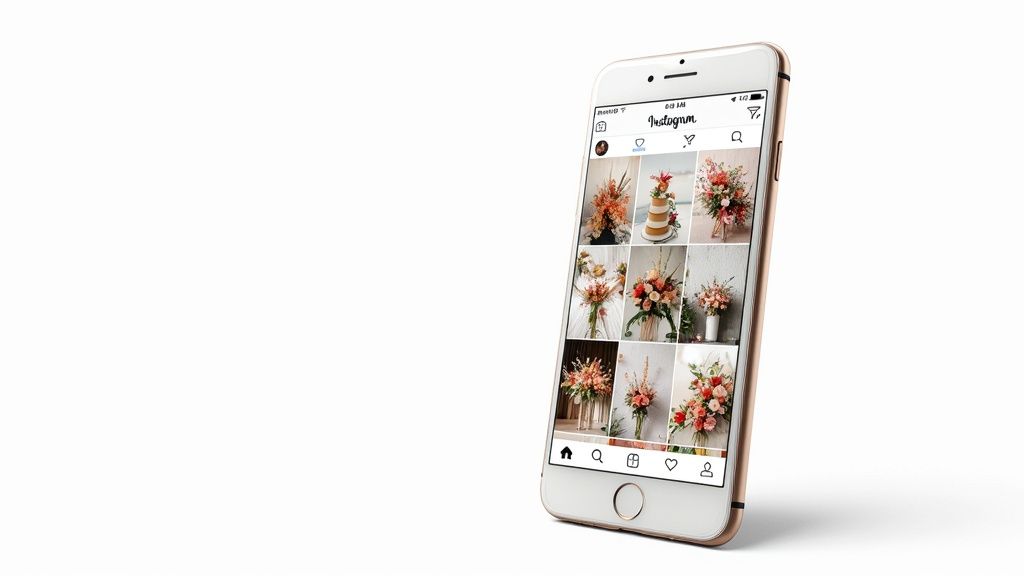
A great, and often overlooked, place to start is your venue. Ask for their preferred vendor list. These are florists who already know the space inside and out—they understand the lighting, the layout, the rules, and the best way to load everything in. That inside knowledge is a huge stress-reliever.
Once you have that list, it's time to go on a visual deep-dive.
Where to Hunt for Floral Talent
- Wedding Blogs & Magazines: Don't just scroll—study. When you find a wedding that feels like you, find the vendor credits and look up that florist immediately. Seeing their work in the context of a full event is invaluable.
-
The Instagram Rabbit Hole: This is where the magic happens. Start with hashtags like
#[YourCity]WeddingFloristor even#[YourVenue]Weddings. You'll uncover local talent and see exactly how other couples have transformed your exact venue. - Strategic Pinterest Searches: When a pin catches your eye, always click through to the original source. More often than not, it will lead you straight to a blog post or a florist's portfolio where you can get a much better sense of their style.
How to Really See a Portfolio
When you land on a florist's website or Instagram feed, you're playing detective. Don't just look for pretty pictures; look for a point of view. A truly talented floral designer has a signature style that shines through, even when they're creating something totally different for each couple.
Look for consistency in quality and style. If every wedding in their portfolio feels unique yet recognizably theirs, you've likely found a true designer, not just a flower arranger. This artistic signature is what ensures your wedding flowers will feel personal and thoughtfully crafted.
Get granular with the details. Are the bouquets well-structured and thoughtfully composed? Do the large-scale installations feel balanced and intentional? You can explore a variety of stunning real wedding floral designs to get a feel for what a cohesive, high-quality portfolio looks like.
Finally, read the reviews. Check Google, The Knot, and WeddingWire to see what past clients are saying. You're looking for comments not just on the beautiful flowers, but on their communication, professionalism, and ability to execute on the big day.
Your goal here is to curate a shortlist of 3-5 top contenders. This is the perfect number to move forward with. You’ve successfully navigated from a sea of endless options to a curated list of artists you’re genuinely excited to talk to.
Making the Most of Your Consultations
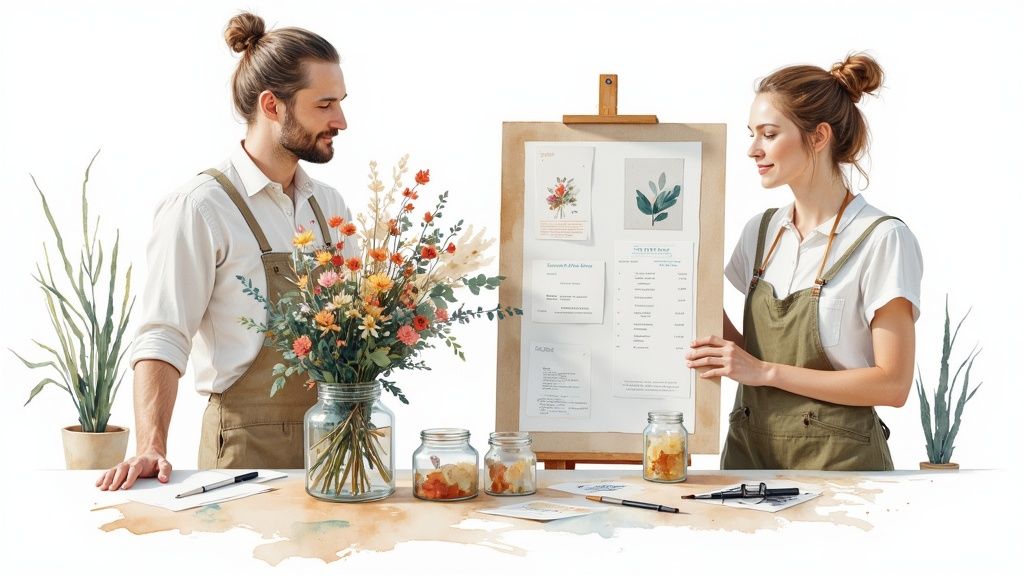
The florist consultation is where the magic really begins. This isn't just another vendor meeting on your checklist; it's a creative interview where you're both deciding if you're the perfect match.
Walking in prepared can transform a simple price check into a vibrant, collaborative design session. It's your chance to truly see if they can take your Pinterest board dreams and turn them into a breathtaking reality. You're not just hiring someone—you're entrusting an artist with a key piece of your wedding's atmosphere.
Come Prepared with the Right Tools
To have a truly productive conversation, you’ll want to bring more than just a few ideas. When you arrive with tangible information, it allows a florist to give you real suggestions and a far more accurate initial quote. It shows you're serious and helps them dive right into brainstorming designs that feel uniquely you.
So, what should you bring?
- Your Vision Board: This is your best friend in the meeting. Whether it’s a Pinterest board or a physical mood board, it’s the fastest way to communicate your color palette, the flower shapes you love, and the overall mood you’re aiming for.
- Your Budget Range: Please, be open about what you're comfortable spending. A true professional will respect your budget completely. They’ll see it as a creative guideline, not a limitation, and can suggest smart swaps or ways to get the biggest visual impact for your investment.
- A Detailed List of Needs: Take some time to think through every single floral element you might want. This means personal flowers (bouquets, boutonnieres, corsages), ceremony arrangements (altar decor, aisle markers), and all the reception pieces (centerpieces, cake flowers, bar arrangements).
Having a clear, itemized list helps prevent surprises down the road and ensures your proposal will accurately reflect everything you want. It’s always easier to scale back from a complete list than to add significant items later on.
Asking Questions That Reveal Their Process
Once you’ve shared your vision, it's your turn to ask the questions. Going beyond "how much will this cost?" is crucial for understanding their design philosophy, their logistical expertise, and honestly, what it’s actually like to work with them.
The right questions can reveal if they're the kind of creative partner who will make this entire process feel enjoyable and completely stress-free.
To help you compare your options and find the perfect fit, we've put together a few essential questions to ask during your consultations.
Key Questions to Ask Potential Wedding Florists
| Question Category | Specific Question to Ask | Why It's Important |
|---|---|---|
| Design & Creativity | "How would you describe your design style, and how do you see it fitting with my vision?" | This helps you gauge their artistic identity and see if they can truly adapt to your specific aesthetic. |
| Sourcing & Seasonality | "Where do you typically source your flowers? Are you able to prioritize local or seasonal blooms?" | This reveals their commitment to quality and sustainability, which can affect the freshness and even the cost of your flowers. |
| Budget & Value | "Based on my budget, where do you suggest we splurge for the biggest impact and where can we be more conservative?" | A great designer will offer strategic advice, showing you how to get the most visual bang for your buck. |
| Logistics & Day-Of | "What does your process look like on the wedding day? Who will be on-site for setup and teardown?" | This clarifies their day-of execution plan and the level of service you can expect, ensuring a smooth and hands-off experience for you. |
These conversations are your best indicator of a good fit. Are they actively listening? Are they asking thoughtful follow-up questions and offering ideas that get you excited? If you feel that creative spark and a sense of trust, you’re on the right track.
To schedule your own consultation and start this exciting conversation, please feel free to reach out to our design team. We can't wait to hear what you're dreaming of.
Alright, the proposals are starting to land in your inbox. This is where the magic from your consultation gets real—with price tags attached. It’s so easy to just skip straight to the bottom line, but trust me, choosing the right wedding florist means digging a little deeper than that.
A solid proposal is more than a list of prices; it’s the blueprint for your wedding day flowers. The best ones are completely itemized, breaking down the cost of every single thing, from the bridal bouquet right down to each reception centerpiece. That kind of transparency is the sign of a true professional who wants you to feel great about where your money is going.
Decoding the Details in Your Proposal
When you’re laying proposals side-by-side, you’re not just comparing costs—you’re comparing value. One quote might look higher at first glance, but a closer look might show it includes full-service setup, delivery to three different locations, and that all-important late-night teardown. A cheaper quote, on the other hand, might leave you on the hook for returning all the vases the next day.
Keep an eye out for a "flower recipe" for the big arrangements. Of course, substitutions can happen because of seasonality, but a good proposal will list the main flowers they plan to use for each piece. This gives you a much clearer picture of the style and quality you’re actually paying for.
Be wary of vague descriptions like "seasonal floral centerpiece." A detailed proposal should get specific about the size, the type of vase, and the key flowers. Think: "low, lush centerpiece in a gold compote bowl featuring garden roses, ranunculus, and eucalyptus." Vagueness is where expectations and reality start to drift apart.
From Proposal to Signed Contract
Once you’ve found the proposal that just clicks with your vision and budget, the contract is the final piece of the puzzle. This is the legal document that protects both you and your florist, so please, never sign anything without reading every single line.
Here are the key things to look for:
- Payment Schedule: Get clear on the deposit amount (which is usually non-refundable to hold your date), when the final payment is due (typically 30 days before the wedding), and how they accept payments.
- Substitution Clause: This is totally standard. It just gives the florist a bit of wiggle room if a specific flower isn't available or up to snuff. The clause should always state that any swap will be of equal or greater value and will stick to your original style and color palette.
- Cancellation Policy: Life is unpredictable. You need to know the terms for cancellation and understand what portion of your payment you might get back at different points along the way.
- Day-Of Logistics: The contract should spell out delivery times, who is handling the setup, and who is responsible for teardown and cleanup at the end of the night.
The wedding flower industry is a massive business—we're talking a global valuation of around $4.2 billion and it's only getting bigger. This growth means you have more options than ever, from big names to amazing local designers. You can actually check out more data on wedding flower market trends if you're curious. A clear, comprehensive contract is what makes sure your partnership is a great one. Reading these documents carefully is how you choose your floral partner with total confidence.
Working With Your Florist Before the Wedding
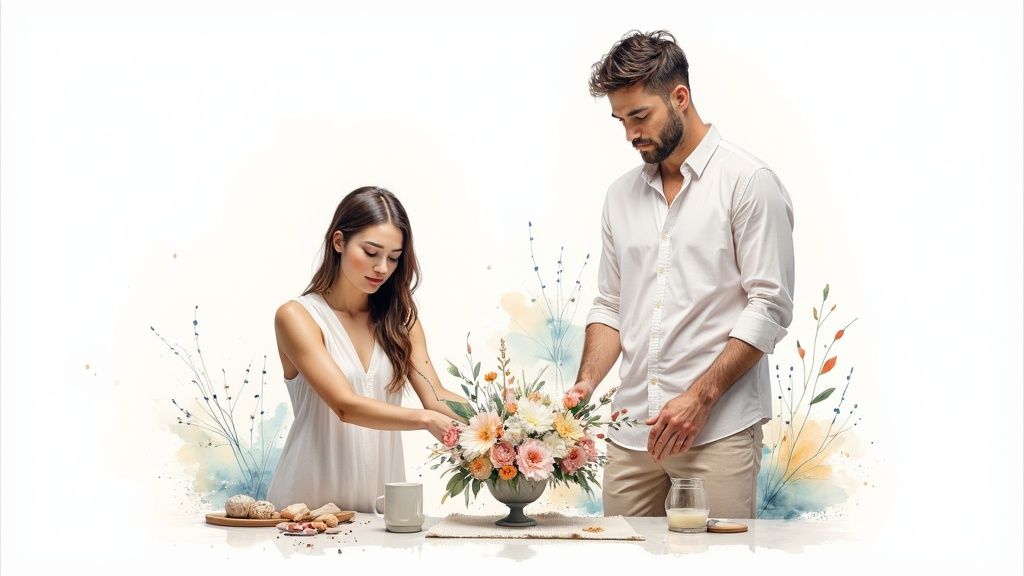
You’ve signed the contract and sent the deposit—huge sigh of relief! But getting that florist booked isn't the finish line; it’s really the start of a fun, creative partnership. The months leading up to your wedding are when the magic truly happens, turning that initial proposal from a document into a living, breathing floral plan.
Honestly, the best floral designs come from a great working relationship. It's all about clear communication and mutual trust. When your designer feels that connection, they're empowered to create their most incredible work for you. This isn’t about micromanaging them, but simply staying in sync at a few key moments.
Most seasoned florists will guide you through the process, but it always helps to know what to expect.
Key Communication Touchpoints
Don't be surprised if things are a bit quiet right after you book. Your florist is likely deep in other couples' wedding weeks! But as your own date gets closer, the communication will naturally pick back up. Here are the milestones you should have on your radar:
- Initial Design Check-In (3-4 Months Out): This is often a quick call or email to touch base and make sure the vision is still locked in. You might have finalized your linen colors or bridesmaid dresses by now, and those details are gold for your florist.
- Nailing Down the Numbers (6-8 Weeks Out): Once your RSVPs start rolling in, you’ll have a much clearer picture of how many centerpieces, corsages, and boutonnieres you'll need. Giving your florist a near-final count now lets them adjust their flower order.
- Final Design Review (4-6 Weeks Out): This is the big one. It's your last chance to go over every single detail together. We're talking bouquet ribbon colors, centerpiece vessel choices, and where exactly that ceremony arch is going. Your final payment is also typically due around this time, usually 30 days before the wedding.
Should You Ask for a Centerpiece Mock-Up?
During that final review meeting, some florists offer to create a centerpiece mock-up. This is a complete sample arrangement, made just for you, so you can see and touch the design before the big day. It's an amazing way to calm any nerves and make sure you're both completely on the same page.
A mock-up can be a game-changer, especially if:
- You’re a visual person who has a hard time picturing the final product from inspiration photos.
- The centerpieces are a significant part of your décor budget and you want to be 100% confident before committing.
- You're torn between a couple of different color palettes or styles and seeing them in person would help you decide.
Just a heads-up: mock-ups aren't usually free. Your florist has to order those specific flowers and dedicate time to creating the arrangement, so there's almost always a cost involved. If this is something you're interested in, bring it up early!
At the end of the day, knowing how to choose a wedding florist also means knowing how to be a great partner. By staying organized and keeping the lines of communication open, you help create a smooth, stress-free process. That's what allows your designer's creativity to really shine, leaving you with breathtaking flowers that are everything you dreamed of.
Common Questions About Choosing a Florist
Diving into the world of wedding flowers for the first time? It's totally normal to have a million questions. Getting the right answers will help you feel confident as you move forward, so you know exactly what to expect from the whole process.
Let's walk through some of the most common things couples ask when they start looking for their perfect wedding florist.
How Much Should I Budget for Flowers?
This is the big one, right? A good rule of thumb is to set aside about 8-10% of your total wedding budget just for flowers. So, if you're working with a $40,000 budget, you're looking at somewhere between $3,200 and $4,000 for your florals.
But honestly, that's just a starting point.
If you’ve been dreaming of lush, over-the-top floral installations that make a huge statement, you might want to bump that up to 15% or even more. On the flip side, if you're leaning toward a more minimalist vibe, you could probably get away with 5-7%.
Just remember, your final cost will really depend on a few things:
- Flower types: Some flowers are just pricier than others. Think peonies and garden roses versus carnations or daisies.
- Seasonality: Choosing blooms that are in-season is always easier on the wallet and guarantees they’ll be at their best.
- Scale: It’s simple math—the more bouquets for your wedding party and centerpieces for guest tables you need, the more it will cost.
When Is the Best Time to Book a Florist?
You’ll want to lock in your florist 6 to 9 months before your wedding day. This is especially crucial if you’re planning to get married during a popular month like June or October, or if you’ve got your heart set on a specific, high-demand floral designer.
Booking this far out gives your designer plenty of time to dream up your designs and source the perfect flowers. It also does two important things for you: it secures your wedding date on their calendar and locks in their current pricing, which is a great way to protect yourself from any future price hikes.
Florist vs. Floral Designer: What Is the Difference?
You’ll hear these terms thrown around a lot, and while people often use them interchangeably, there’s a subtle but important difference.
A traditional florist is often what you think of when you picture a local flower shop. They're amazing at creating beautiful, classic arrangements for all sorts of occasions, from birthdays to anniversaries.
A floral designer, however, tends to focus exclusively on events, especially weddings. They offer a much more comprehensive, hands-on service. They’re not just providing flowers; they’re helping you create a whole vibe. A great floral designer will think about everything from your table linens to the lighting to make sure the flowers perfectly complement the entire aesthetic of your day. If you’re aiming for a really cohesive, customized look, a floral designer is almost always the way to go.
It's not just about flowers, is it? We find that as couples get deeper into planning, they start asking about the traditions and details behind other wedding elements, like the differences between wedding and engagement rings. Getting clear on all these little things makes the whole process feel so much more manageable.
Ready to bring your wedding flower vision to life? At Fiore, our team of expert floral designers specializes in creating custom arrangements that tell your unique story. From intimate bouquets to grand installations, we serve all of Los Angeles with artistic, unforgettable designs. Contact us today to schedule your complimentary consultation!
